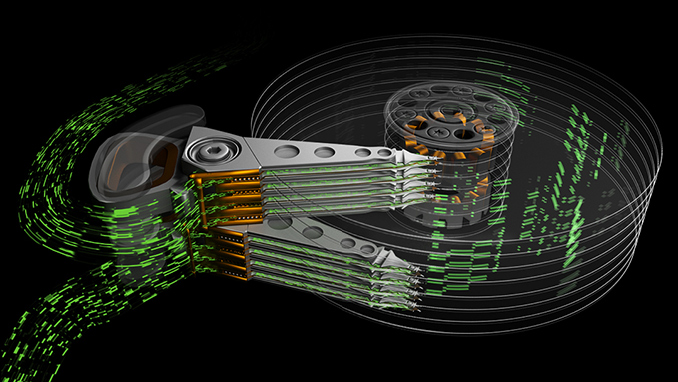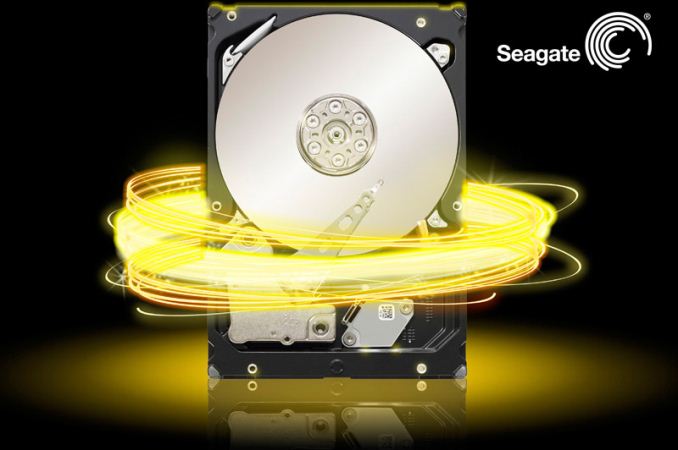Seagate’s Multi Actuator Technology to Address HDD IOPS Woes
by Anton Shilov on December 29, 2017 12:01 PM EST
Seagate introduced its new Multi-Actuator Technology (MAT) for hard drives earlier this month. It promises to increase hard drive performance by using two or more sets of actuator arms that operate independently from a single pivot point. Seagate claims that next-gen HDDs will require higher performance to effectively take advantage of their increased capacities. It plans to use MAT in their datacenter hard drives going into pilot production in 2018.
To improve the performance of next-generation hard drives, Seagate proposes to install not one, but two (or more) sets of actuators into a single HDD. The actuators are to be equipped with their own arms/heads as well as magnets to position them, but will use one pivot. As a result, the actuators will be able to act completely independently, essentially creating parallelism within a single hard drive. With an architecture like this, IOPS performance will scale with the number of actuators. Aggregate read/write performance of hard drives will also increase, but since it will depend on many factors, it is too early to make predictions regarding throughput of next-gen HDDs. The additional components required for two independent actuator assemblies (and a considerably more sophisticated HDD controller) will make such hard drives more expensive to build when compared to today’s models. This could be one of the reasons why Seagate plans to use its Multi-Actuator Technology only for hard drives designed for datacentres, where hardware costs are not as crucial as performance and features.
The first-generation MAT-enabled HDDs are to use two actuators operating on a single pivot point (along with 8 platters and 16 heads), but going forward the number of actuators may grow. Seagate says that the host computer can “treat a single Dual Actuator drive as if it were two separate drives”, but stresses that logically the HDD will remain a single device with two access streams for communication, just like dual-port SAS drives do. Meanwhile, Dual Actuator HDDs will be able to use not only SAS, but also NVMe and SATA interfaces. In the best-case scenario, a hard drive with two actuators can double the random read/write performance and almost double the sequential read/write performance compared to today's hard drives. The sequential access case is a bit tricky, since the cylinder height gets halved with two actuators, and a lot depends on how the addresses are translated to the actual physical sectors.
The arrival of new magnetic recording technologies in the coming years will significantly increase capacities of hard drives for cloud/exascale datacenters to over 20 TB by 2020 and to 40 TB within the next five or seven years. The upcoming HDDs will increase their sequential read/write performance along with the increase of their areal densities, but when it comes to latencies and random read and write operations, things get more complicated. The current HDD architecture uses a single actuator that synchronously moves all the arms with read-write heads over the media together for reading and writing data. With such an architecture, the platters can only work on one request at a time. Meanwhile, the more data an HDD stores, the more requests it gets and the more time it spends seeking the right track/sector. If/when fulfilling a request takes too long, quality of service (a metric dear to datacenter operators) suffers. Today, the performance bottleneck is solved by using either NAND flash or multiple hard drives in parallel, effectively combining their performance for certain access traces. At some point, this approach may become inefficient due to power/complexity and other factors. Therefore, it is imperative that HDDs get faster in order to cope with tomorrow’s workloads.
Seagate says that the Multi-Actuator Technology is to be deployed on products in the near future, but does not disclose when exactly. As the company’s blog post on the matter mentions both MAT and HAMR, it is highly likely that commercial hard drives featuring HAMR due in late 2019 will also have two actuators on a single pivot. At the same time, it does not mean that the MAT is not going to find itself a place in products using conventional PMR.
Related Reading
- Western Digital Stuns Storage Industry with MAMR Breakthrough for Next-Gen HDDs
- Toshiba Announces 14 TB PMR MG07ACA HDD: 9 Platters, Helium-Filled, 260 MB/s
- Toshiba Commercializes SDK’s 9th Gen PMR, Tech Enables 14 TB PMR HDDs in 2018
- Western Digital Now Shipping 14 TB HDDs: HGST Ultrastar Hs14 with 1000 Gb/in2
- Western Digital Announces Ultrastar He12 12 TB and 14 TB HDDs
- Seagate Announces Enterprise Capacity 12 TB HDD: 2nd-Gen Helium-Filled Hard Drives
Source: Seagate











88 Comments
View All Comments
Bullwinkle-J-Moose - Friday, December 29, 2017 - link
"Why do we care about how fast an SSD copies data on itself? Is this really a bottleneck for any common use cases?"-----------------------------------------------------------------------------------------------------------
Because it accurately shows how fast an SSD can simultaneousy Read and Write data
or in other words.......
Why then would we care how fast a new Seagate HDD copies data to and from itself simultaneously?
jordanclock - Saturday, December 30, 2017 - link
Well, I don't care about how fast a new Seagate HDD copes to and from itself. I care about how fast data enters and leaves the drive to other mediums, like most people or businesses would.These drives sound fantastic for read-intensive activities, especially where you're pulling lots of small reads scattered across large data containers.
Bullwinkle-J-Moose - Saturday, December 30, 2017 - link
"I care about how fast data enters and leaves the drive to other mediums, like most people or businesses would."---------------------------------------------------------
The internal copy/paste test shows how fast the drive itself is able to read and write at the same time
This is the MAXIMUM speed at which data can enter and leave the drive at the same time which was what you were most interested in
Data cannot enter and leave the drive faster than the internal throughput of the drive itself but can be slower due to how the drive is connected to the rest of the system
Internal throughput can be considerably higher than connected system throughput and an ideal drive would read and write data simultaneously as fast as it's (PCIe?) connection allows while at the same time read and write data internally at an even faster rate with proper onboard processing
With PCIe 5.0 arrival, 16 lanes of read / write to and from the drive in addition to the on-board / internal data handling (copy / paste 0 speed would make a great starting point for the next gen drives after 2020
Bullwinkle-J-Moose - Saturday, December 30, 2017 - link
Ideally, a 20 core CPU running several VM's should have a multilane, parallel processing drive to match itMaximum simultaneous read / write to and from the drive with high speed simultaneous internal data handling is just what the doctor ordered for massive multi-core operations
Bullwinkle-J-Moose - Saturday, December 30, 2017 - link
0 = )mode_13h - Friday, December 29, 2017 - link
The speedup (in IOPS volume) will likely be close to N, where N is the number of actuators. However, latency wouldn't significantly drop, since you're probably still talking about writing to a pre-determined location that needs to be accessed by a specific actuator.Where I can see a super-linear speedup is that the actuator/head assembly mass should decrease by close to 1/N. However, the time to write a cluster should similarly decrease (assuming clusters are striped across the platters).
What I want to know is whether & to what extent each actuator needs to compensate for what the other is doing. When an actuator accelerates, it's not only moving itself, but the entire drive. The tracks are so thin that I'd imagine the drive *must* move by at least a couple track widths, during a typical seek. With multiple actuators moving around, it seems like each would need to compensate for how the others are moving the drive. This could be why such techniques aren't commonplace.
mode_13h - Friday, December 29, 2017 - link
Sorry, I meant to say the speed of writing a cluster should drop to 1/N - not the time. So, that would partially offset the benefit of multi-actuator. In other words, you seek time would halve (with 2 actuators) but your write time would double.That said, I know seeking is the part they're worried about, and dominates the time needed to perform small writes.
StevoLincolnite - Friday, December 29, 2017 - link
Electrons moving down a conduit will never reach the speed of light.https://en.wikipedia.org/wiki/Speed_of_electricity
ddrіver - Saturday, December 30, 2017 - link
Nothing with mass ever reaches the speed of light. But since most people here got a TV education what can you expect?chaos215bar2 - Sunday, December 31, 2017 - link
Data in a wire is not transmitted by particles with mass. It’s transmitted by the electric field created by said particles, which does propagate at the speed of light — more or less.